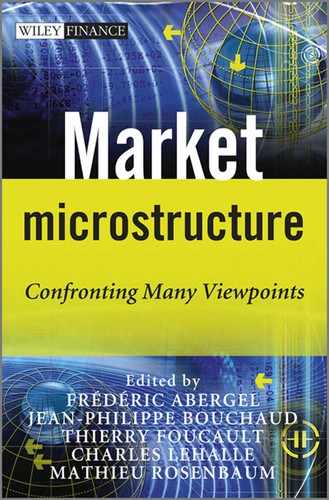Introduction
The accumulation of high frequency market data in recent years has revealed many surprising results. These results are interesting both from theoretical and practical standpoints. The mechanism of price formation is at the very heart of economics; it is also of paramount importance to understand the origin of the well-known anomalous ‘stylized facts’ in financial price series (heavy tails, volatility clustering, etc.). These issues are of obvious importance for practical purposes (organisation of markets, execution costs, price impact, etc.). This activity is also crucial to help the regulators, concerned with the organisation of liquidity in electronic markets and the issues raised by ‘high frequency trading’.
Correspondingly, this problem has been vigorously investigated by at least five different communities (economics, financial mathematics, econometrics, computer science and econo-physics), scattered in academic institutions, banks and hedge funds, with at present limited overlap and sometimes lack of visibility. On the other hand, due to the gigantic amount of available data, precise quantitative theories can now be accurately tested.
At the time where this conference series started in 2010, the interest for market microstructure had finally reached a stage where the interest for the theoretical breakthroughs of the pioneers in the field had become comparable to its practical importance for market practitioners. Thanks to the development of high frequency trading, market microstructure is now, not only a subject of theoretical modelling and simulation but, more interestingly maybe, a real practical field where a better model can make a big difference.
The organisers of the conference thought that it would be extremely fruitful to confront the ideas that have blossomed in those different communities in the past decade. In order to foster this confrontation and ease communication, we have gathered researchers from these different communities, including professionals, and ask them to give introductory tutorials, reviewing both their recent activity and the problems that, in their eyes, are most relevant to address in the near future.
Our aim in setting up this friendly, knowledge-oriented confrontation has been to examine and compare possibly very different views on the nature of the mechanisms relevant to describe and understand what one can actually observe when scrutinising the tick-by-tick behaviour of markets. Such important questions as the interplay between liquidity taking and providing, the existence and characterisation of various types of market impact, the statistical tools designed to handle well the ‘tick’ effect, the ‘best-execution’ and other algorithmic trading strategies, or the question of market design and organisation … have been studied in-depth by the speakers at the conference, and their contributions to this present volume will help shed a new light, or, rather, new lights, on the market microstructure viewed as an object for scientific study as well as a wealth of information for price discovery and trading.
Frédéric Abergel
Jean-Philippe Bouchaud
Thierry Foucault
Charles-Albert Lehalle and
Mathieu Rosenbaum
